牛津幼儿英语3a教案
牛津3a教案

牛津3a教案教案标题:《牛津3A教案》教学目标:1. 通过本节课的学习,学生能够掌握并正确使用本单元的重点词汇和短语。
2. 学生能够听懂、理解并正确运用本单元的重点语法结构。
3. 学生能够运用所学知识进行口头和书面表达,以描述人物、地点、物品等。
4. 学生能够通过合作学习和小组活动,提高他们的交流和合作能力。
教学重点:1. 掌握本单元的重点词汇和短语。
2. 理解并正确运用本单元的重点语法结构。
3. 运用所学知识进行口头和书面表达。
教学准备:1. 《牛津3A》教材及相关教学资源。
2. 多媒体设备。
3. 学生练习册和笔。
教学步骤:Step 1: 导入新课 (5分钟)1. 向学生简要介绍本节课的学习内容和目标。
2. 利用多媒体设备展示与本单元相关的图片或视频,引发学生的兴趣和好奇心。
Step 2: 词汇和短语学习 (15分钟)1. 通过幻灯片或黑板展示本单元的重点词汇和短语。
2. 请学生跟读并注意正确的发音和词义。
3. 进行词汇和短语的巩固练习,如单词拼写、选择题等。
Step 3: 语法讲解 (15分钟)1. 通过多媒体设备或黑板展示本单元的重点语法结构。
2. 用简单明了的语言解释语法规则,并给出例句进行说明。
3. 引导学生进行语法练习,如填空、改错等。
Step 4: 口头表达练习 (15分钟)1. 将学生分成小组,给每个小组分配一个话题,如"我的家人"、"我的学校"等。
2. 学生在小组内进行讨论并准备展示,鼓励他们使用本单元的重点词汇和短语。
3. 每个小组派出代表进行展示,并鼓励其他学生提问和互动。
Step 5: 书面表达练习 (15分钟)1. 给学生分发练习册,并指导他们完成与本单元相关的书面表达练习。
2. 鼓励学生使用所学知识进行描述和写作,可以提供一些提示词语或句子。
Step 6: 小结和反馈 (5分钟)1. 对本节课的学习进行小结,并强调学生在学习中取得的进步和成就。
上海版牛津英语3A全册教案
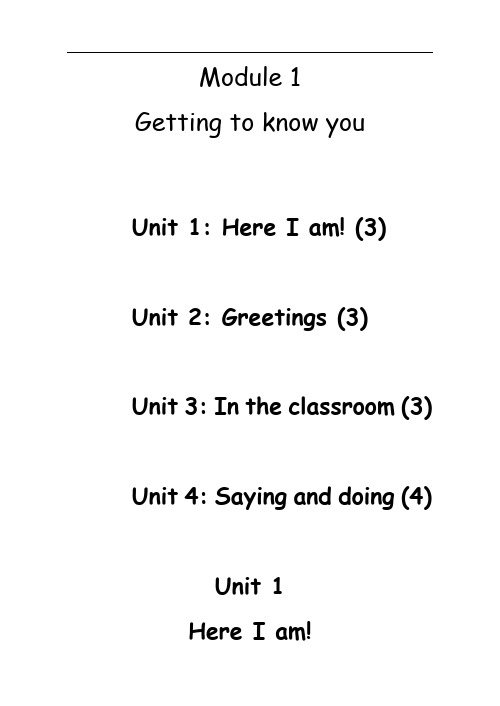
Module 1Getting to know youUnit 1: Here I am! (3)Unit 2: Greetings (3)Unit 3: In the classroom (3) Unit 4: Saying and doing (4)Unit 1Here I am!Tasks and clusters of tasksGreetings●Learners sing the “Hello” song●Learners sing the “Alphabet song”Language learning objectivesFunctions●Greeting people●Introducing oneselfLanguage/Vocabulary●Capital letters: A-Z●Small letters: a-zFormulaic expressions●Hello/Hi,…SkillsSpeaking●Using modelled phrases to communicate with teachers andlearners●Opening an interactionResources●Student’s Book 3A P2-4●Word and Picture Cards 3A●Cassette 3A●Photocopiable page1●Workbook 3A P1●Grammar Practice Book 3A P1●Student’s self-assessment sheet P57The First PeriodDimension targets:●To establish and maintain relationships in carrying out classroomactivities●Develop an awareness and enjoyment of the basic sound patternsof English through a songLanguage focus:●Using formulaic expressions to greet people (e.g. Hello.)●Using formulaic expressions to intr oduce oneself (e.g. I’m Alice.) Language skills:Speaking:●Use modelled phrases to communicate with teachers and otherlearners.●Open an interaction by greeting someone politely●Open an interaction by introducing oneself Steps:Pre-task preparation:1.Put the large picture of Dotty on the blackboard so that all thestudents can see it. Introduce Dotty. Say: Hello, Dotty.Encourage the class to say: Hello, Dotty.2.Say: Hello. The students answer: Hello.Divide the class into pairs. The students say Hello to each other.Say Hello. I’m Miss Doris to individual students to elicit: Hello.I’m (student’s name).While-task procedure:1.In groups, the individual students introduce themselves to oneanother. They say: Hello. I’m … The rest of the group responds: Hello, …2.Listen to the song: Hello.3.Play the song again. Encourage the students to sing along withthe cassette.4.Invite individuals to sing the song, substituting Dotty with theirown name.Post-task activities:1.Play a relay race: Hello. I’m …2.Play a game: Toss a soft toy to one student who says: Hello. I’m …3.Explain the contraction: I’m is the same as: I am.4.Workbook page 1a)Explain the rubric: Trace and match.b)Introduce and explain: Woof!c)Trace the line and match the speech bubble with correctcharacter on the page with their pencils.d)Explain the rubric: Stick, trace and write.e)Stick their photos or draw their pictures in the frame and writetheir names.Consolidation:At this stage Grammar Practice Book 3A page 1 could be used to practise and consolidate the oral and written language in this section further.The Second PeriodDimension targets:●Recognize … the sound patterns of English.Language focus:●Learning the capital letters: A-Z●Learning the small letters: a-zMaterials:●Student’s Book 3A page 3●Cassette 3A and a cassette player●Alphabet CardsSteps:While-task procedure:1.Show the alphabet cards A-Z one by one while playing thecassette. Students listen to the names of the 26 letters and learn to recognize the capital letters.2.Show the alphabet cards A-Z randomly and ask students to sayin chorus, groups or individually.3.Recognize the alphabet cards a-z in the same way.Post-task activities:Listen again so that students can revise and memorize the alphabet.The Third PeriodDimension targets:●Recognize … the sound patterns of English.Language focus:●Learning the capital letters: A-Z●Learning the small letters: a-zMaterials:●Student’s Book 3A page 4●Cassette 3A and a cassette player●Alphabet CardsSteps:Pre-task preparation:1.Show the alphabet cards A-Z and a-z randomly to revise theletters.2.Ask individual students to pick out pairs of capital and smallletter cards and say the letters.3.Read out the letters in consecutive order and ask students torepeat in chorus.While-task procedure:1.Play the casse tte for “The alphabet song”. Listen to the song.2.Play the song again and encourage students to sing along.3.Students sing “The alphabet song” in chorus and groups. Student’s self-assessment:In groups, refer the students to the self-assessment sheet on page 57 and have them discuss their opinion about each task in this unit and what they think they have learned. Have each student fill in the sheet accordingly with the appropriate amount of support from me, depending on individual students’ ability.Unit 2GreetingsTasks and clusters of tasksGreetings●Learners identify and use a wider range of greetings●Learners enact a role-play: How are you?Language learning objectivesFunctions●Greeting people●Introducing oneself●Taking leaveFormulaic expressions●How are you? Fine, thanks.●Good morning, …●Goodbye, …SkillsListening●Recognizing differences in the use of intonation●Closing an interactionSpeaking●Using modelled phrases to communicate with teachers andlearners●Opening an interaction●Closing an interactionResources●Student’s Book 3A P5-7●Word and Picture Cards 3A●Cassette 3A●Photocopiable pages 2-7●Workbook 3A P2-3, P33-34●Grammar Practice Book 3A P2-4●Student’s self-assessment sheet P57The First PeriodDimension targets:●To establish and maintain relationships in carrying out classroomactivities●Recognize … the sound patterns of EnglishLanguage focus:●Using formulaic expressions to greet people (e.g. Good morning,Miss Fang.)Language skills:Listening:Discriminate between words with different initial sounds a-, b-, c-, d-.Speaking:●Use modelled phrases to communicate with teachers and otherlearnerse.g. Good morning, Miss Fang.●Pronounce correctly words in isolation with initial sounds a-, b-,c-, d-.Materials:●Student’s Book 3A page 5●Cassette 3A and a cassette player●Alphabet Cards: A a, B b, C c, D d●Word and Picture Cards 3A●Workbook 3A pages 33 and 34Preparation:Bring any soft toy.Steps:While-task procedure:e a soft toy to demonstrate: Good morning, (name of toy).Ask individual students to greet the toy in the same way.2.Say Good morning to the students. They respond: Good morning.3.Practice in pairs: Good morning.4.Listen to the cassette and repeat.Learn the letters:1.Play the cassette: Learn the letters; A ‘a’ apple2.The students listen and point.3.Listen, point and repeat the letter A and the sound “a”.4.Repeat the process with B ‘b’ bag, C ‘c’ cat and D ‘d’ dog.5.Workbook pages 33 and 34.The Second PeriodDimension targets:To establish and maintain relationships in carrying out classroom activitiesLanguage focus:●Using formulaic expressions to greet people and bid farewell● e.g. Hi! Good morning. Goodbye.Language skills:Speaking:●Use modelled phrases to communicate with teacher and otherlearners●Open an interaction by greeting someone politely e.g. Hello.●Open an interaction by greeting peers using appropriateformulaic phrasese.g. Hi!●Close an interaction by using appropriate formulaic phrasese.g. Goodbye.Materials:●Student’s Book 3A page 6●Cassette 3A and a cassette player●Word and Picture Cards 3A●Workbook 3A page 2Preparation:Bring any soft toy.Steps:Pre-task preparation: (for role-play on page 7)e a soft toy to demonstrate: Hi, (name of toy).Ask individual students to greet the toy in the same way.Say: Goodbye, (name of toy), and put the toy away. Make the toy wavegoodbye.Bring out the toy again. Ask the students to say: Hi, then: Goodbye, andput the toy away.Repeat the activity until the students are responding freely. 2.Explain that Hi is informal and for use between students. Theymust say Hello when they greet me and other adults.3.Play the cassette for the first two pictures.4.Read the first two dialogues.5.Divide the class into groups of three. The groups choosecharacters and practise the conversation.6.Act out the first two dialogues7.Learn the next two pictures in the same way.8.Groups of four can practise the role-play.9.Act the dialogues using their own names.10.Workbook page 2Consolidation:At this stage Grammar Practice Book 3A pages 2 and 3 could be used to practise and consolidate the oral and written language in this section further.The Third PeriodDimension targets:●To establish and maintain relationships in carrying out classroomactivities●Obtain and provide information in simple classroom situationsthrough role-playLanguage focus:●Using formulaic expressions to greet people and take leavee.g. Goodbye.●Using formulaic expressions to ask how someone is, andrespondinge.g. How are you? Fine, thinks.Language skills:Speaking:●Open an interaction by greeting someone politely●Open an interaction by eliciting a responsee.g. How are you?●Close an interaction by using appropriate formulaic expressionse.g. Goodbye.Materials:●Student’s Book 3A page 7●Cassette 3A and a cassette player●Word and Picture Cards 3A●Workbook 3A page 3●Photocopiable pages 2-7Steps:Pre-task preparation:●Greetings●Introduce: How are you? Fine, thanks. (Use two soft toys tomodel the dialogue)●Repeat the dialogue several times.●Chain drill around the class.●Play the cassette for the whole of page 7. Listen and repeat. While-task procedure:●Practise the dialogue in groups of six.●Select groups to act out the dialogue.●Before performing the role-play, each student may introducehis/her own character. (e.g. Hello. I’m Mr Li.)Post-task activities:●Select groups to act the modified dialogues.●Workbook page 3Consolidation:At this stage Grammar Practice Book 3A pages 4 could be used to practise and consolidate the oral and written language in this section further.Student’s self-assessment:In groups, refer the students to the self-assessment sheet on page 57 and have them discuss their opinion about each task in this unit and what they think they have learned. Have each student fill in the sheet accordingly with the appropriate amount of support from me,depending on individual students’ ability.Unit 3In the classroom Tasks and clusters of tasksPeople and things●Learners use name-cards for introductions●Learners play recognition games (people and objects) Language learning objectivesFunctions●Greeting people●Asking a person’s name●Introducing oneself●Describing conditions●Confirm/deny●Identifying people and thingsLanguage/Vocabulary●Pronoun: You●Countable nouns: book, pencil, bag, desk, rubber, ruler●Verb to be: are (You’re … )●Indefinite article “a”●Wh-question: What’s your name?Formulaic expressions●Hello, …●One, two, three, I see … ? (passive)●Yes/No, I’m …SkillsListening●Locating specific information givenSpeaking●Using modelled phrases to communicate and elicit responses ●Opening an interaction by eliciting a response Resources●Student’s Book 3A P8-10●Word and Picture Cards 3A●Cassette 3A●Photocopiable pages 2-8●Workbook 3A P4-6, P35-37●Grammar Practice Book 3A P5-6●Student’s self-assessment sheet P58The First PeriodDimension targets:●Interpret and use simple given information through followingsimple instructions●Establish and maintain relationships in carrying out classroomactivityLanguage focus:●Using formulaic expressions to greet people (e.g. Hello.)●Asking Wh-questions to find out a person’s identity (What’s yourname?)●Using verbs to introduce oneself (I’m Danny.)Language skills:Listening:●Understanding simple instructions e.g. Colour your name card.●Discriminate between words with different initial sounds e-, f-,g-, h- and i-.Speaking:●Use modelled phrases to communicate and elicit responses.(What’s your name?)●Open an interaction by eliciting a response●Pronounce correctly words in isolation with initial sounds e-, f-,g-, h- and i-.Materials:●Student’s Book 3A page 8●Cassette 3A and a cassette player●Workbook 3A pages 4; 35, 36 and 37Steps:Pre-task preparation:●Introduce: What’s your name? to elicit: I’m … The students holdup their name cards as they answer.●Practice in pairs.●Play the cassette for page 8. Listen and repeat.●Read the dialogue.●Explain the contraction: What’s is the same as What is.While-task procedure:Have a relay race.Divide the class into groups and play the game as illustrated on page 8.Post-task activities:Workbook page 41.Read the dialogue. Ask the students to supply the missing wordsorally.2.Ask individuals to write the missing words on the blackboard.3.Trace and write the missing words in the book.Learn the letters:1.Play the cassette. Listen and point in their books.2.Listen, point and repeat the sound.3.Have the students enter the vocabulary in the relevant page oftheir personal vocabulary book.4.Workbook pages 35, 36 and 37 Consolidation:At this stage Grammar Practice Book 3A pages 5 could be used to practise and consolidate the oral and written language in this section further.The Second PeriodDimension targets:●Obtain information through interactive games●Establish and maintain relationshipsLanguage focus:●Using verbs to describ e conditions (e.g. You’re __.)●Using formulaic expressions to confirm/deny identity (Yes, I’m__./No, I’m __.)Language skills:Use modelled phrases to communicate and elicit a response Materials:●Student’s Book 3A page 9●Cassette 3A and a cassette player●Word and Picture Cards 3A●Workbook 3A page5●Photocopiable pages 2-6 and 8Steps:Pre-task preparation:●Introduce: You’re …; Yes; No.●Play the cassette for page 9.●Listen and repeat.●Read the dialogue.While-task procedure:Play the game in small groups at the front of the classroom. Post-task activities:Workbook page 51.Review the letters a to f. Write the letters on the blackboard.2.Read the statements on page 5.3.Write the correct letters in the table. Consolidation:At this stage Grammar Practice Book 3A pages 5 could be used to practise and consolidate the oral and written language in this section further.The Third PeriodDimension targets:Obtain information through interactive gamesLanguage focus:●Using a formulaic rhyming expression to start a guessing game ●Using nouns to identify common classroom objects●Using the indefinite article to refer to something for the firsttimee.g. I see a book.●Using formulaic expressions to affirm and deny (e.g. Yes/No) Language skills:Speaking:Open an interaction by eliciting a responseListening:Recognize differences in the use of intonationMaterials:●Student’s Book 3A page 10●Cassette 3A and a cassette player●Word and Picture Cards 3A●Workbook 3A page6Steps:Pre-task preparation:●Introduce the new vocabulary, using classroom realia and thepicture cards.●Practise the nouns by using flashcards and pointing to the items.●Encourage individual students to do the same.While-task procedure:Play the guessing game in pair.Post-task activities:Workbook page 61.Read the nouns on page 6.2.Trace the words, join the objects and the words and colour theobjects.Consolidation:At this stage Grammar Practice Book 3A pages 6 could be used to practise and consolidate the oral and written language in this section further.Student’s self-assessment:In groups, refer the students to the self-assessment sheet on page 58 and have them discuss their opinion about each task in this unit and what they think they have learned. Have each student fill in thesheet accordingly with the appropriate amount of support from me, depending on individual students’ ability.Unit 4Saying and doingTasks and clusters of tasksIn the classroom●Learners say a number rhyme●Learners make number cards●Learners use their number cards in a number recognition game ●Learners follow the routine of tidying the classroom beforeleavingLanguage learning objectivesFunctions●Using simple imperatives●Expressing thanks●Identifying things●Identifying numbersLanguage/Vocabulary●Imperative: Close/Open the door/box. Come in. Clean theblackboard.●Definite article: ‘the’●Nouns: blackboard, door, window, box, tableFormulaic expressions●(Imperative), please.●Thank you.SkillsListeningLocating specific informationSpeakingUsing modelled phrases to communicate with teachers and learners Resources●Student’s Book 3A P11-14●Word and Picture Cards 3A●Cassette 3A●Photocopiable pages 9-13●Workbook 3A P7-9, P37-39●Grammar Practice Book 3A P8-11●Student’s self-assessment sheet P58The First PeriodDimension targets:●Develop an awareness and enjoyment of the basic sound patternsof English through participating in saying and enacting a rhyme ●Establish and maintain relationships in carrying out classroomactivity●Obtain and provide objects in simple classroom situationsthrough playing an interactive game●Interpret and use information through matchingLanguage focus:●Using simple imperatives to give instructions (e.g. Come in,please.)●Using simple imperatives to express prohibitions (e.g. Don’t belate.)Language skills:Listening:●Identify key words in an utterance by recognizing stress●Recognize alliterative and rhyming words●Discriminate between words with different initial sounds j-, k-,l-, and m-.Speaking:●Use modelled phrases to communicate with other learners●Pronounce correctly words in isolation with initial sounds j-, k-, l-,and m-.Materials:●Student’s Book 3A page 11●Cassette 3A and a cassette player●Workbook 3A pages 7; 37, 38 and 39●Photocopiable page 9Steps:Pre-task preparation:●Introduce numbers 1-10. A large toy clock with moveable handsis an ideal prop. Show a set of number cards.●Write numbers 1-10 on the blackboard and practise counting.●Count in a chain round the class.Display the number cards(1-10) in disorder on the board ledge.Ask students to come out and put the numbers in order as quickly as they can. Then, count from 1 to 10.While-task procedure:1.Practise: Look at the clock/board. Close/Open the door.2.Listen to the rhyme and repeat it.3.Read the rhyme. Then, try to recite.Post-task activities:Workbook page 74.Review numbers 1-10 using the number cards.5.Trace and colour the numbers on page 7.Listening task:Listen and write down the missing numbers.Learn the letters:5.Play the cassette. Listen and point in their books.6.Listen, point and repeat the sound.7.Workbook pages 37, 38 and 39 Consolidation:Grammar Practice Book 3A pages 8 and 9 give further practice in identifying numbers 1-10.The Second PeriodDimension targets:●Establish and maintain relationships in carrying out classroomactivities●Interpret and use information to follow simple instructions Language focus:●Using imperatives to give simple instructions (e.g. Clean thetable, please.)●Using formulaic expressions to express thanks (e.g. Thank you.)●Using definite article to refer to specific classroom objects●Using nouns to identify thingsLanguage skills:Listening:Locate specific information in response to simple instructions Speaking:Use modelled phrases to communicate with other learners Materials:●Student’s Book 3A page 12●Cassette 3A and a cassette player●Word and Picture Cards 3A● A cardboard box with lid●Card and scissors●Workbook 3A pages 8 and 9●Photocopiable page 10Steps:Pre-task preparation:1.Introduce: the door/table/window/blackboard/box.2.Say: Look at the blackboard/door/table/window/box. Thestudents perform the actions.3.Introduce: Clean the blackboard/table. Open/Close thedoor/box.4.Practice the instructions, with the students performing theactions.Post-task activities:●Play a simplified version of Simon Says as a class activity.●Workbook page 8●Review the vocabulary.●Trace and write the words.●Workbook page 91.Read the dialogues and decide on the answers.2.Select pairs to read the dialogue.3.Circle the correct verbs and trace the faint words.4.The pairs practice the dialogue.5.Act out the dialogue.Consolidation:At this stage Grammar Practice Book 3A pages 10 and 11 could be used to practice and consolidate the oral and written language in this section further.The Third PeriodDimension targets:●Establish and maintain relationships in carrying out classroomactivities●Obtain and provide information in simple classroom situationsthrough role-playLanguage focus:●Using formulaic expressions to greet people and take leave (e.g.Goodbye.)●Using formulaic expressions to ask how someone is, andresponding● e.g. How are you? Fine, thanks.Language skills:1.Open an interaction by greeting someone politely2.Open an interaction by eliciting a response (How are you?)3.Close an interaction by using appropriate formulaic expressions Materials:●Student’s Book 3A page 14●Cassette 3A and a cassette player●Paper or card to make number and word cards 1-10●Strings for the numbers game and 10 clothes-pegs●Photocopiable page 13Steps:Pre-task preparation: (1)e two soft toys to model the dialogue.2.The class should repeat the dialogue several times3.Listen to the cassette and repeat it.While-task procedure: (1)Practise the dialogue in groups of four.Select groups to act the dialogue for the class.Post-task activities: (1)1.Extend the task by having the same groups practice the dialogue,substituting their own names.2.Select groups to act the modified dialogues. Check students’pronunciation, and correct if necessary.3.Photocopiable page 13: Act a story.4.Make number cards and put the numbers in order. Student’s self-assessment:In groups, refer the students to the self-assessment sheet on page 58 and have them discuss their opinion about each task in this unit and what they think they have learned. Have each student fill in the sheet accordingly with the appropriate amount of support from me, depending on individual students’ ability.Assessment:Module 1: Getting to know you Units 1-4Module 2Me, my family and friends Unit 1: My friends (3)Unit 2: Feelings (3)Unit 3: Families (6)Unit 1My friendsTasks and clusters of tasksGreetings●Learners identify their classmates in terms of size●Learners play a recognition game●Learners perform an action rhyme featuring adjectives of size Language learning objectivesFunctions●Introducing oneself●Identifying people●Mentioning something for the first time●Describing people●Finding out a person’s identityLanguage/Vocabulary●Predicative adjectives: fat, thin, big, small, tall, short●Wh-question: Who are you/is he/is she?●Who is your friend?●Pronoun: he, she, I’m/You’re … He’s/She’s …●Nouns: boys, girls, mothers, teachers, babies, friend●Definite article: a girlFormulaic expressions●Hello/Hi, …SkillsSpeaking●Using modelled phrases to open and maintain an interaction byproviding information in response to factual questions Listening●Identifying key words in an utterance by recognizing stress●Locate specific information in response to simple questions Writing●Add personal ideas and information to writing when a frameworkis providedResources●Student’s Book 3A P15-17●Wallpictures 3A●Word and Picture Cards 3A●Cassette 3A●Photocopiable page14●Workbook 3A P10-12, P39-41●Grammar Practice Book 3A P12-14●Student’s self-assessment sheet P59The First PeriodDimension targets:●Establish and maintain relationships in carrying out classroomroutines●Provide and present simple information on a familiar topic●Obtain information through an interactive gameLanguage focus:●Asking Wh-questions to find out a person’s identi ty (e.g. Whoare you?)●Using indefinite articles to mention something or someone forthe first time(e.g. I’m a girl.)●Using adjectives to describe people (e.g. I’m tall.)Language skills:Speaking:●Use modelled phrases to open and maintain an interaction byproviding information in response to factual questions(e.g. Who are you? I’m a girl. I’m tall.)Listening:●Locate specific information in response to simple questions Writing:●Add personal ideas and information to writing when a frameworkis providedMaterials:●Student’s Book 3A page 15●Cassette 3A and a cassette player●Word and Picture Cards 3A●Wallpictures 3A●Workbook 3A page 10●Magazines and scissorsSteps:Pre-task preparation:1.Select pairs of students to illustrate: tall/short, big/small,thin/fat2.Introduce: tall/short, big/small, thin/fat3.Play the cassette for Look and Say.4.Practise the adjectives using the flashcards.5.Introduce: Who are you?6.Ask Who are you? to elicit:I’m (name). I’m a boy/girl. While-task procedure:1.Encourage the students to talk about themselves in terms ofsize and sex, using the About you model.2.Play a guessing game.Post-task activities:Workbook page 101.Read 1 and 2 on page 10. Explain: Tick.2.The students complete 3 and 4.3.Select students to read the completed statements in 2, 3 and4.4.Explain the task. Students draw their picture in the panel andcomplete their own description.5.Ask individuals to read out the description of themselves Consolidation:At this stage Grammar Practice Book 3A page 12 could be used to practise and consolidate the language in this section further.The Second PeriodDimension targets:●Provide and present simple information on a familiar topic●Obtain information in simple classroom situations throughrole-playLanguage focus:●Asking Wh-quest ions to find out a person’s identity (Who is myfriend?)●Using pronouns to identify people (e.g. He’s Eddie.)●Using adjectives to describe people (e.g. She’s small.) Language skills:Listening:●Identify key words in an utterance by recognizing stresse.g. Who is he? He’s tall.●Locate specific information in response to simple questions●Discriminate between words with different initial soundsn-, o-, p- and q-.Speaking:●Use modelled phrases to open and maintain an interaction byproviding a response to factual questions●Pronounce correctly words in isolation with initial sounds n-, o-,p- and q-.Writing:●Add personal information to writing when a framework isprovidedMaterials:●Student’s Book 3A page 16●Cassette 3A and a cassette player●Word and Picture Cards 3A●Workbook 3A pages 11; 39, 40 and 41●Photocopiable page 14Steps:Pre-task preparation:●Review: tall, short, thin, fat, big, small.●Introduce: Who is he/she? ; He’s/She’s (name) ; friend.●Go around the class asking Who’s he/she? to elicit: He’s/She’s__ .●Play the cassette. Listen and repeat.●Practice Who’s he/she?。
牛津幼儿英语3A教案
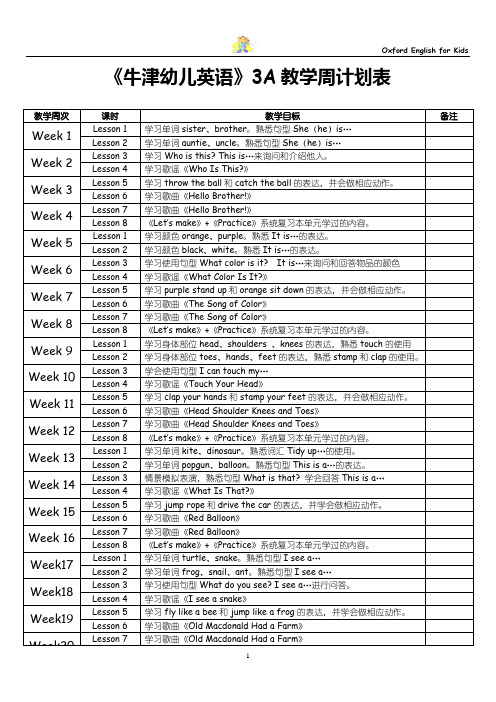
《牛津幼儿英语》3A教学周计划表教学周次课时教学目标备注Week 1 Lesson 1 学习单词sister、brother。
熟悉句型She(he)is…Lesson 2 学习单词auntie、uncle。
熟悉句型She(he)is…Week 2 Lesson 3 学习Who is this? This is…来询问和介绍他人。
Lesson 4 学习歌谣《Who Is This?》Week 3 Lesson 5 学习throw the ball和catch the ball的表达,并会做相应动作。
Lesson 6 学习歌曲《Hello Brother!》Week 4 Lesson 7 学习歌曲《Hello Brother!》Lesson 8 《Let’s make》+《Practice》系统复习本单元学过的内容。
Week 5 Lesson 1 学习颜色orange、purple。
熟悉It is…的表达。
Lesson 2 学习颜色black、white。
熟悉It is…的表达。
Week 6 Lesson 3 学习使用句型What color is it? It is…来询问和回答物品的颜色Lesson 4 学习歌谣《What Color Is It?》Week 7 Lesson 5 学习purple stand up和orange sit down的表达,并会做相应动作。
Lesson 6 学习歌曲《The Song of Color》Week 8 Lesson 7 学习歌曲《The Song of Color》Lesson 8 《Let’s make》+《Practice》系统复习本单元学过的内容。
Week 9 Lesson 1 学习身体部位head、shoulders 、knees的表达,熟悉touch的使用Lesson 2 学习身体部位toes、hands、feet的表达,熟悉stamp和clap的使用。
牛津3A教案
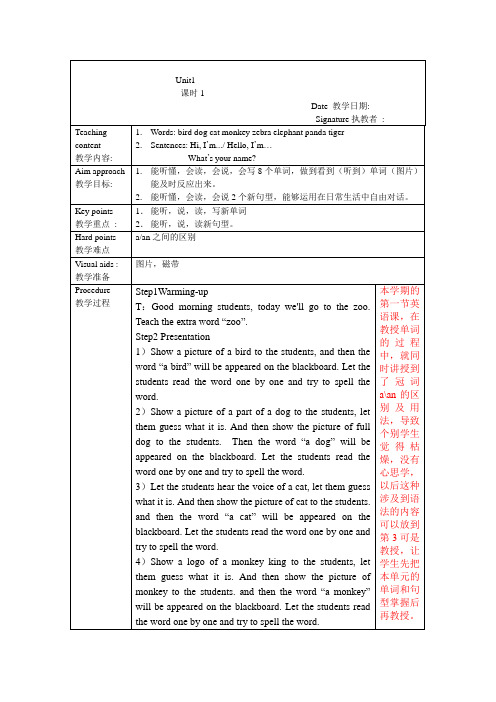
<1>Show a picture of a dog, a cat, a
bird and a monkey to the students, let the students say the word. <2>Match 6)Show a picture of a zebra to the students, and then the word ―a zebra‖ will be appeared on the blackboard. Let the students read the word one by one and try to spell the word. 7)Show a picture of bamboos to the students, let the students guess which animal eats bamboos, and then show a picture of a panda to them, the word ―a panda‖ will be appeared on the blackboard. Let the students read the word one by one and try to spell the word. 8)Show a picture of a tiger to the students, and then the word ―a tiger‖ will be appeared on the blackboard. Let the students read the word one by one and try to spell the word. 9)Let the students hear the voice of an elephant, let them guess what it is. And then show the picture of cat to the students. and then the word ―an elephant‖ will be appeared on the blackboard. Let the students read the word one by one and try to spell the word. Step3 Practice Exercise: <1> Match <2> Show a picture of eight animals to the students, let them read it. Step4 Consolidation Explain the different of the article ―a/an‖.The initial of the word is ―a,e,i,o,u‖ uses ―an‖,the others uses ―a‖. Read the new words together.
牛津上海版-3A-M3U1-My-school教案
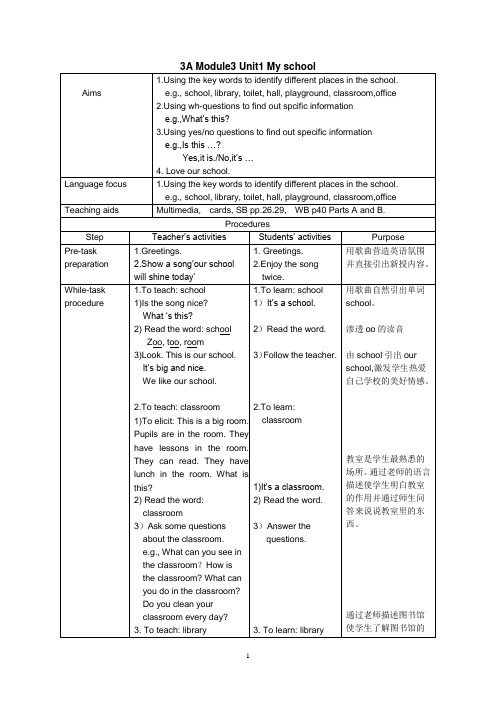
T: Look . This is a new boy.
He is new here. He is Peter. He asks the way.
What are they talking?
Please look and listen to the dialogue.
4)I can run/jump/play football/play basketball/skip a rope…
5.To learn the drills and practise the new words.
6.To learn: toilet
1)Look and listen
2)Read and choose.
What ‘s this?
2) Read the word: school
Zoo, too, room
3)Look. This is our school.
It’s big and nice.
We like our school.
2.To teach:classroom
1)To elicit: This is a big room. Pupils are in the room. They have lessons in the room. They can read. They have lunch in the room. What is this?
Do you clean your classroom every day?
3. To teach: library
1)To eliicit: There are many books in a big room. We can read many different kinds of books there. And we can borrow some books from there too. What is it? It’s a library.
牛津3A UNIT2 第二课时教案

2 To be able to know the letters : Ee Ff Gg
LANGUAGE FOCUS
The words and the sentences.
AIDS
Please say hello to him.
(1)S1:Hello,Bobby.I’m…
Bobby: Hello.
(2)S2:Hello,I’m…Are you Bobby?
Bobby: Yes, I am.
2Show the picture:Sam
T: Look, this is Sam.
Try to say hello to him.
(3)抄写字母
字母的书写要求学生认真仔细,养成良好的习惯
1.Recite Story time
2.Finish the exercises
Unit 2 I’m Liu Tao
A:Hello,I’m…Are you…?
B:Yes,I am.
No,I’m not.I’m
Teacher’s Reflection
look at the picture,listen to the tape and answer the questions
Introduce the name:John
read
1.Show the picture:Bobby.
T: Look, who is coming? He’s Bobby.
Word cards and PPT.
PROCEDURES
CONTENTS
METHODS
【精品】上海版牛津3AModule1Unit3period1教案
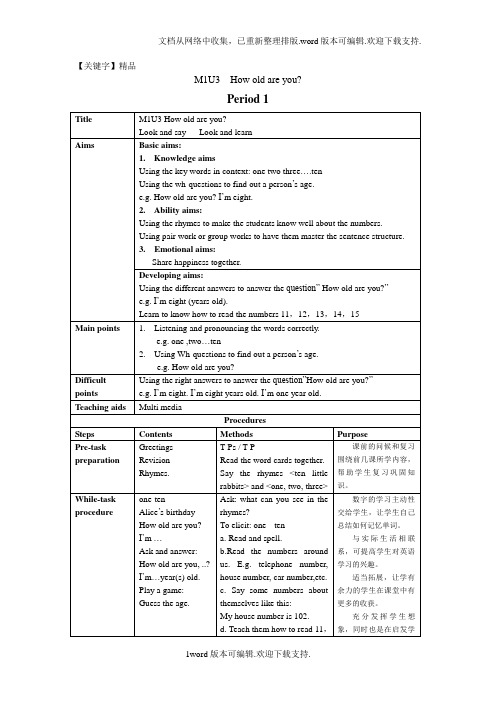
e.g. How old are you?I’m eight.
2.Ability aims:
Using the rhymes to make the students know well about the numbers.
e.g.I’m eight (years old).
Learn toknowhow to read the numbers 11,12,13,14,15
Main points
1. Listening and pronouncing the words correctly.
e.g. one ,two…ten
2.whats your name my name is alice
————————————————————————————————————————————————————————————————————————————————————————————————————————————————————————————————————————----------------------------------------------
To elicit: one year old
Ask four students stand in the front of the classroom and put on the animal tire, andtherest students guesstheirages using:
-----Hi, what’s your name?
【关键字】精品
M1U3 How old are you?
译林牛津3A全册教案

译林牛津3A全册教案译林牛津3A全册教案了“自我介绍”和“询问对方姓名”的功能项目,并在词汇教学中,选择了较易激起小学生学习兴趣的动物类单词。
这样安排有助于消除学生学习新语言的焦虑心理。
进而激发学生参与教学的热情和信心。
教学要求:1.能听懂、会说以下日常交际用语,并能运用所学交际用语进行自我介绍及询问对方姓名。
Hello/Hi ,I’m …What’s your name?要求读音正确,语调自然。
特别要注意I’m 和name 的正确读音。
2.培养学生运用所学英语进行交际的意识和勇气。
3.认识五个人物:David ,Liu Tao ,Yang Ling ,Mike ,Nancy .4. 能听懂、会说以下八个动物类单词:a dog, a cat , a bird , a tiger ,a monkey , a zebra , a panda ,an elephant 。
要求读音正确。
5.会唱歌曲Hello!6.理解冠词a /an 之间的区别。
教学重点:见教学要求1、2、4。
教学难点:见教学要求:1、4、6。
教具准备:录音机(带)、动物卡片、人物头饰。
课时安排:共四课时。
第一课时:A Learn to say.第二课时:B Look and learn .第三课时:C Look and say .第四课时:D Fun house .Unit 1 Hello .The first period: A Learn to say .TEACHING CONTENTS:1.Vocabulary :David ,Liu Tao ,YangLing ,Mike ,Nancy .2.Pattern : Hi /Hello ,I'm …Wh at’s your name ? Good morning .TEACHING AIMS :1.t’s your name?Good morning .2.To know five persons : David ,Liu Tao, YangLing ,Mike ,Nancy .3.To encourage the Ss to talk in English .TEACHING AIDS :Cassette ,recorder ,masks (David ,Liu Tao ,YangLing ,Mike ,Nancy )TEACHING PROCEDURES:Step 1: Warm-up1.Introduce : Allow me to introduce myself .My name is …,You can call me “Mr /Miss ××.”This semesterI teach you English .I hope we could get along with each other .First ,let’s say “Hello !”2.Greetings: Hello! Hi ! Good morning/Good afternoon .Step2 Presentation and practice .1.Learn to say :Hi /Hello ,I’m …a. T: If you want to introduce yourself to others ,you should say : Hi ,I’m …/Hello ,I’m…b. Read after the T.Hi ,I’m… /Hello ,I’m…c. Practice :T& S S&S Group work .Work in pairs .d. Check .2.Learn to say:What’s your name?a. The teacher wears the mask (David ): Hello,I’m David ,What’s your name?The student answers :Hello ,I’m…b. Read after the T: What’s your name?Pronounce : name [ei]c. Ask and answer : What’s your name?Hi,I’m…d. Check .Step 3 Break : Listen to the song “Hello!”Step4 Consolidation:1. The T shows the masks (David ,Liu Tao, YangLing ,Mike ,Nancy ) : Please introduce yourself to them and ask“What’s your name?”e.g Hi ,I’m … ,What's your name?Hello, I’m …2.Play a game: What’s your name?The Ss are divided for several groups .In each group ,the Ss ask and answer one by one .e.g Sa: Hi ,I’m … What’s your name?Sb: Hi ,I’m … (Sa&Sb clap their ha nds )Sb :Hi, I’m … What’s your name?Sc: Hi ,I’m …(Sb&Sc clap their hands )3.Listen to the tape and repeat .Step5 Relax :Listen to the song “Hello!”;Try to sing together (老师做简单律动,学生跟做,试唱) Step 6 Homework Listen to the tape and read aloud .Say “Goodbye .”POSTSCRIPT: Phonetic symbolThe second period :B Look and learn .TEACHING CONTENTS :Vocabulary : a dog ,a cat ,a bird ,a tiger ,a monkey , a zebra ,a panda ,an elephant .TEACHING AIMS:1.To understand and say the words :a dog ,a cat ,a bird ,a tiger ,a monkey ,a zebra ,a panda ,anelephant .2.To understand what’s the difference between “a .”and “ an .”3.To encourage the Ss to learn English .TEACHING PROCEDURES :Step 1 Warm-up .1.Greetings:Hello ,everyone!Hello,I’m …What’s your name?2.Introduce .Please introduce yourself to others (Prtactice in groups ).3.Check .Step2 Presentation and practice .1.Learn to say the new word: a dog .a.Show the card (dog)T: Hi ,boys and girls ,I’m Dog .(Please say “Hello”to Dog)Ss: Hello,Dog.b. Practice and check .c. Imitate “Dog” (Use body language )2.Look at the picture and say “Hello ,Dog/Cat /..”3.听录音做动作。
牛津英语3a unit1教案
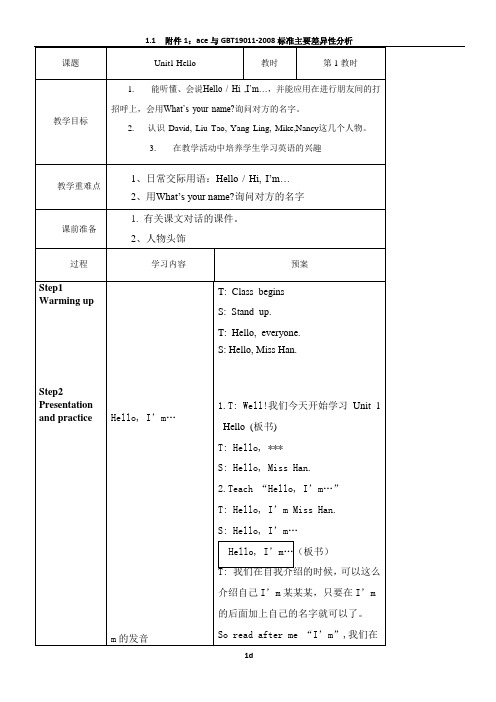
T:The last one教师拿出图片。
S:狗
T: Yes, ”dog”
dog a dog
⑶A game: Magic eyes
T:Now let’s readafterthe tape, turn to page 8.
听录音,做补充习题Part B
朗读单词zebra, elephant, bird, monkey
S: a monkey and an elephant
教师说明做法,特别是要指明四幅图的位置及做法
Are you ready?
S: Yes.
T:Go!
学生听录音答题。
T: Let’s check.
Picture a “ a panda”教师举起手中的书,同时进行。
Picture b? Who can? Hands up!
教
后
反
思
课题
Unit1 Hello
过程
学习内容
预案
Step1.Free talk and motivation
Step2.Presentation and practice
Step3.Read after the tape
Step4.听力练习
Step5 Homework
Hi/Hello, I’m… What’s your name?
2、看图编对话
课前准备
课前准备上节课八种动物的图片及单词卡片。(bird, dog, cat, monkey, elephant, zebra, panda, tiger)
过程
学习内容
预案
Step1Free talk
Step 2 Look and say.
牛津3A教案Unit3Thisismyfather
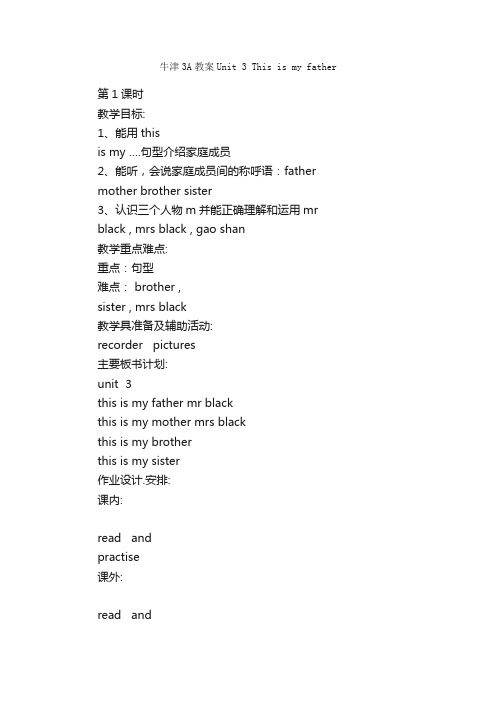
牛津3A教案Unit 3 This is my father第1课时教学目标:1、能用thisis my ….句型介绍家庭成员2、能听,会说家庭成员间的称呼语:father mother brother sister3、认识三个人物m并能正确理解和运用mr black , mrs black , gao shan教学重点难点:重点:句型难点: brother ,sister , mrs black教学具准备及辅助活动:recorder pictures主要板书计划:unit 3this is my father mr blackthis is my mother mrs blackthis is my brotherthis is my sister作业设计.安排:课内:read andpractise课外:read andrecite教学过程:一.revision1.复习对话 this is ….nice to meet you2. groupwork二.presentationt: today i’ll showyou some family.now look at the tv.so what’s the relationship between them?s: 是一个家庭。
t: so who’s the manhere?s:父亲t: yes, so he is thefather.read after to me”father”教师带领学生齐读后,开火车练习,可以两个、两个学生进行,可以节省时间。
t: today we will go tothe next unit,unit3this is my father.so read after me”this is my father.”1.新授图1(1)出示头饰mr green .nancy 新授father, mr black 分解跟读(2)新授“this is myfather , mr black ”(3)解说场景 listen tothe tape(4)read after the teather , then read together (5)分小组朗读(6)groupwork2.新授图2(1)出示头饰mr blackdavid 新授mother。
上海版牛津3AModule1Unit3period2教案
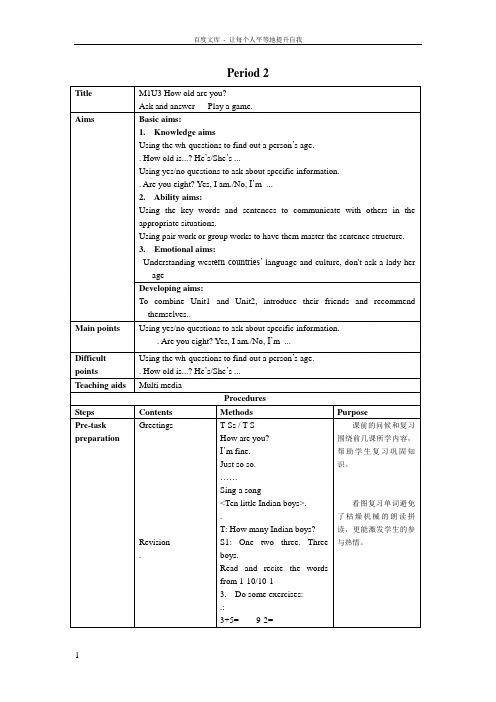
Period 2Title M1U3 How old are you?Ask and answer Play a game.Aims Basic aims:1.Knowledge aimsUsing the wh-questions to find out a person’s age.. How old is...? He’s/She’s ...Using yes/no questions to ask about specific information.. Are you eight? Yes, I am./No, I’m...2.Ability aims:Using the key words and sentences to communicate with others in theappropriate situations.Using pair work or group works to have them master the sentence structure.3. Emotional aims:Understanding west ern countries’ language and culture, don't ask a lady herageDeveloping aims:To combine Unit1 and Unit2, introduce their friends and recommendthemselves..Main points Using yes/no questions to ask about specific information.. Are you eight? Yes, I am./No, I’m...Difficult points Using the wh-questions to find out a person’s age. . How old is...? He’s/She’s ...Teaching aids Multi mediaProceduresSteps Contents Methods PurposePre-taskpreparationGreetingsRevision. T-Ss / T-SHow are you?I’m fine.Just so so.……Sing a song<Ten little Indian boys>..T: How many Indian boys?S1: One two three. Threeboys.Read and recite the wordsfrom 1-10/10-13.Do some exercises:.:3+5= 9-2=课前的问候和复习围绕前几课所学内容,帮助学生复习巩固知识。
牛津3a教案

牛津3a教案教案标题:牛津3a教案教学目标:1. 通过本课学习,学生将能够掌握牛津3a教材中所涉及的词汇和句型。
2. 学生将能够运用所学的知识进行听、说、读、写的综合能力训练。
3. 学生将能够培养合作学习和自主学习的能力。
教学重点:1. 学习并掌握本课的新词汇和句型。
2. 提高学生的听力理解能力。
3. 培养学生的口语表达能力。
教学难点:1. 学生对于新词汇和句型的理解和运用。
2. 学生对于听力材料的准确理解和答题能力。
教学准备:1. 牛津3a教材及相关教学资源。
2. 多媒体设备。
3. 学生练习册和作业本。
教学过程:Step 1: 导入(5分钟)通过展示一些与本课相关的图片或实物,引起学生的兴趣,激发他们的学习欲望。
例如,展示一张关于动物的图片,并问学生是否知道这些动物的英文名字。
Step 2: 新知呈现(15分钟)在本步骤中,教师将向学生介绍本课的新词汇和句型。
教师可以通过图片、示范、游戏等方式进行呈现,帮助学生理解和记忆新知识。
Step 3: 听力训练(20分钟)教师播放与本课相关的听力材料,要求学生仔细听并回答相关问题。
教师可以适当调整听力难度,确保学生能够理解并回答问题。
Step 4: 口语练习(15分钟)教师组织学生进行口语练习,可以采用小组讨论、角色扮演等形式,让学生运用所学的知识进行对话练习。
教师可以提供一些话题或情境,引导学生展开对话。
Step 5: 阅读与写作(20分钟)教师引导学生阅读课文,并进行相关的阅读理解练习。
随后,教师布置写作任务,要求学生根据所学的内容,写一篇关于自己喜欢的动物的短文。
Step 6: 小结与反馈(5分钟)教师对本节课的重点内容进行小结,并针对学生的表现给予积极的反馈。
同时,教师可以布置一些相关的练习作业,巩固学生所学的知识。
Step 7: 课堂延伸(10分钟)教师引导学生进行课堂延伸活动,例如,学生可以自由选择一个动物,进行相关的研究并进行展示,让其他同学了解更多关于该动物的知识。
3a 牛津英语教案 unit6
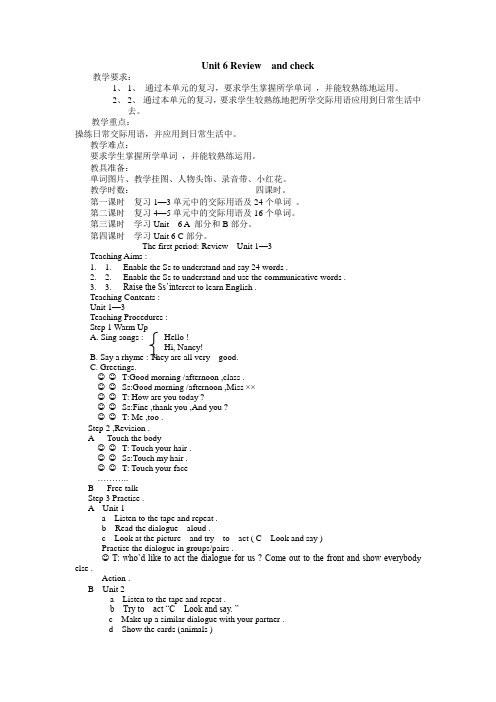
Unit 6 Review and check教学要求:1、1、通过本单元的复习,要求学生掌握所学单词,并能较熟练地运用。
2、2、通过本单元的复习,要求学生较熟练地把所学交际用语应用到日常生活中去。
教学重点:操练日常交际用语,并应用到日常生活中。
教学难点:要求学生掌握所学单词,并能较熟练运用。
教具准备:单词图片、教学挂图、人物头饰、录音带、小红花。
教学时数:四课时。
第一课时复习1—3单元中的交际用语及24个单词。
第二课时复习4—5单元中的交际用语及16个单词。
第三课时学习Unit 6 A部分和B部分。
第四课时学习Unit 6 C部分。
The first period: Review Unit 1—3Teaching Aims :1. 1.Enable the Ss to understand and say 24 words .2. 2.Enable the Ss to understand and use the communicative words .3. 3.Raise the Ss’int erest to learn English .Teaching Contents :Unit 1—3Teaching Procedures :Step 1 Warm UpA. Sing songs : Hello !Hi, Nancy!B. Say a rhyme : They are all very good.C. Greetings.☺☺T:Good morning /afternoon ,class .☺☺Ss:Good morning /afternoon ,Miss ××☺☺T: How are you today ?☺☺Ss:Fine ,thank you ,And you ?☺☺T: Me ,too .Step 2 ,Revision .A Touch the body☺☺T: Touch your hair .☺☺Ss:Touch my hair .☺☺T: Touch your face………..B Free talkStep 3 Practise .A Unit 1a Listen to the tape and repeat .b Read the dialogue aloud .c Look at the picture and try to act ( C Look and say )Practise the dialogue in groups/pairs .☺T: who’d like to act the dialogue for us ? Come out to the front and show everybod y else .Action .B Unit 2a Listen to the tape and repeat .b Try to act “C Look and say. ”c Make up a similar dialogue with your partner .d Show the cards (animals )(1)(1)What’s this ,do you know ?( e.g a bird )(2)(2)What’s colour is it ? ( e.g green )(3)(3)Read after the T (e.g a green bird )e Sing and dance “Colour song ”C Unit 3a Listen to the tape and repeat .b Play a game (V oice game )用A部分交际用语中的关键词玩一个小把戏,比如:“Mr Green ”一词,老师大声说,学生小声说,或反之。
牛津幼儿园英语3教案

牛津幼儿园英语3教案教学目标:1. 能够听懂、认读并正确书写26个英文字母;2. 能够用英语介绍自己的家庭成员;3. 能够用英语描述自己的日常活动和喜好。
教学重点:1. 26个英文字母的认读和书写;2. 家庭成员的介绍;3. 日常活动和喜好的描述。
教学难点:1. 英文字母Q、X、Y的发音和书写;2. 家庭成员介绍中的复杂句式;3. 日常活动和喜好的描述中的词汇和句式。
教学准备:1. 教学课件;2. 英文字母卡片;3. 家庭成员图片;4. 日常活动图片;5. 录音设备。
教学过程:一、热身活动(Warm-up)。
1. 教师用英语问候学生,引导学生用英语回答。
2. 教师播放英语儿歌,让学生跟随节奏拍手、跳舞。
二、学习英文字母(Learning the English Alphabet)。
1. 教师出示英文字母卡片,用英语念出每个字母,并让学生跟读。
2. 教师播放英语字母歌曲,让学生跟着歌曲念出每个字母。
3. 学生分组进行英文字母拼图游戏,加深对英文字母的认识。
三、介绍家庭成员(Introducing Family Members)。
1. 教师出示家庭成员的图片,用英语介绍自己的家庭成员,并让学生模仿。
2. 学生分组进行家庭成员角色扮演,用英语介绍自己的家庭成员。
四、描述日常活动和喜好(Describing Daily Activities and Hobbies)。
1. 教师出示日常活动和喜好的图片,用英语描述自己的日常活动和喜好,并让学生模仿。
2. 学生进行小组讨论,用英语描述自己的日常活动和喜好,然后向全班展示。
五、总结(Summary)。
1. 教师对本节课学习内容进行总结,并强调重点。
2. 教师布置下节课的预习任务。
六、作业(Homework)。
1. 要求学生复习26个英文字母的书写和发音。
2. 要求学生用英语写一篇介绍家庭成员的短文。
3. 要求学生用英语描述自己的日常活动和喜好。
教学反思:本节课通过多种形式的教学活动,使学生在轻松愉快的氛围中学习了英语字母、家庭成员介绍以及日常活动和喜好的描述。
译林版牛津英语3A全册教案
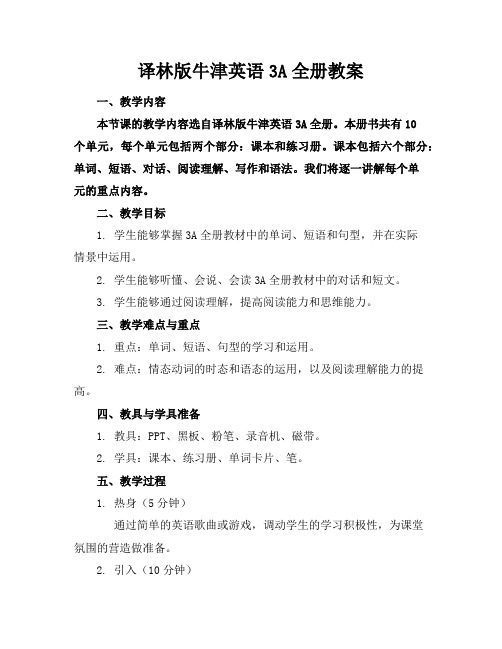
译林版牛津英语3A全册教案一、教学内容本节课的教学内容选自译林版牛津英语3A全册。
本册书共有10个单元,每个单元包括两个部分:课本和练习册。
课本包括六个部分:单词、短语、对话、阅读理解、写作和语法。
我们将逐一讲解每个单元的重点内容。
二、教学目标1. 学生能够掌握3A全册教材中的单词、短语和句型,并在实际情景中运用。
2. 学生能够听懂、会说、会读3A全册教材中的对话和短文。
3. 学生能够通过阅读理解,提高阅读能力和思维能力。
三、教学难点与重点1. 重点:单词、短语、句型的学习和运用。
2. 难点:情态动词的时态和语态的运用,以及阅读理解能力的提高。
四、教具与学具准备1. 教具:PPT、黑板、粉笔、录音机、磁带。
2. 学具:课本、练习册、单词卡片、笔。
五、教学过程1. 热身(5分钟)通过简单的英语歌曲或游戏,调动学生的学习积极性,为课堂氛围的营造做准备。
2. 引入(10分钟)通过展示图片或实物,引导学生用英语进行描述,引出本节课的主题。
3. 新课呈现(20分钟)讲解新课内容,包括单词、短语、句型。
通过例句和练习,让学生理解和掌握新知识。
4. 课堂练习(10分钟)设计随堂练习,让学生在实际操作中运用所学知识,巩固新课内容。
5. 阅读理解(10分钟)让学生阅读短文,回答相关问题,提高学生的阅读理解和思维能力。
6. 课堂小结(5分钟)7. 作业布置(5分钟)布置作业,包括单词抄写、练习册题目和家庭阅读任务。
六、板书设计根据课堂内容,设计简洁明了的板书,帮助学生理解和记忆。
七、作业设计1. 单词抄写:抄写本节课所学的单词,每个单词写三遍。
2. 练习册题目:完成练习册上的相关题目。
3. 家庭阅读任务:阅读一本英语绘本,并简要介绍故事内容。
八、课后反思及拓展延伸本节课结束后,教师应认真反思教学效果,针对学生的掌握情况,调整教学策略。
同时,鼓励学生参加英语角、英语演讲比赛等活动,拓展英语学习渠道,提高学生的英语水平。
深圳牛津英语 3A 教案 unit 4 Period 1
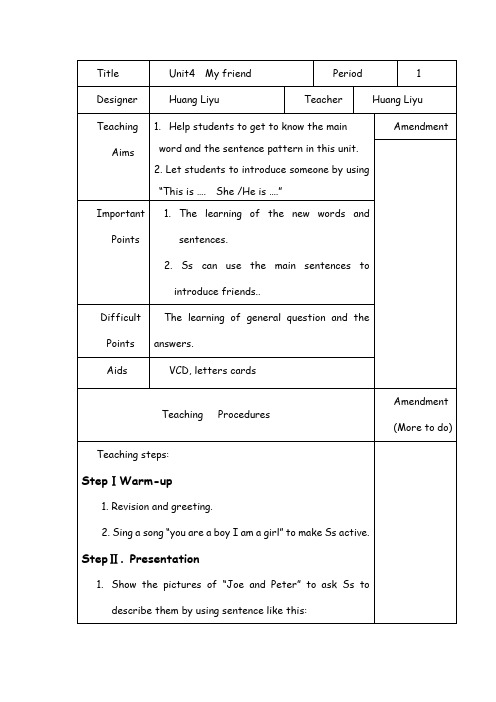
StepⅤ.Homework
1.Copy the words and sentences.
boy girl You’re = You are
I’m a boy. I’m a girl.
Title
Unit4 My friend
Period
1
Designer
Huang Liyu
Teacher
Huang Liyu
Teaching
Aims
1.Help students to get to know the main
word and the sentence pattern in this unit.
T:Who is this? And how is him?
Ss:He isJoe. He is fat.
T:How about this one?
Ss:He is peter. He is thin.
2.Show Ss the new words “fat and thin”.
T; F A T fat, T H I N thin.
1.Revisionand greeting.
2. Sing a song “you are a boy I am a girl” to make Ss active.
StepⅡ. Presentation
1.Show the pictures of“Joe and Peter” to ask Ss to describe them by using sentence like this:
上海版牛津英语3A教案新部编本
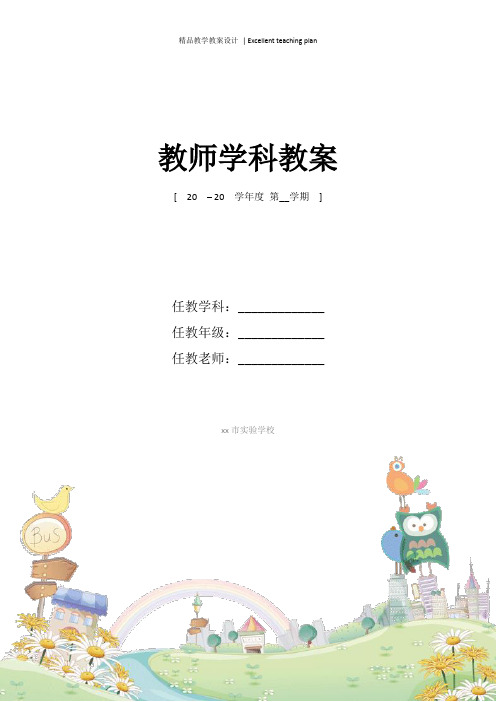
教师学科教案[ 20 – 20 学年度第__学期]任教学科:_____________任教年级:_____________任教老师:_____________xx市实验学校Module 1 Getting to know youUnit 1 Hello I a m!Period OneTe a ching contents: Listen / Sing (P. 2)Te a ching A ims:1.知识目标:To know the word: p a rrot a nd its n a me: Dotty;Using formul a ic expressions to greet people;Using formul a ic expressions to introduce oneself;C a n sing the song: Hello, I’m Dotty.2.能力目标:Use modeled phr a ses to communic a te with te a chers a nd other le a rners; Open a n inter a ction by introducing oneself.3.情感目标:How to greet people a nd introduce oneself politely.Difficult a nd key points: I’m… / The song.Te a ching a ids: Pictures, the word c a rds a nd the phr a se c a rds.To stick the pictures on the bo a rd.Period TwoTe a ching contents: Look a nd s a y (P. 3)Te a ching A ims:1.知识目标:Le a rning the c a pit a l letters: A-Z;Le a rning the sm a ll letters: A-z2.能力目标:C a n recognize, re a d a nd copy the letters. Difficult a nd key points: The lettersTe a ching a ids: Pictures, The A lph a bet C a rds.1. Look a t the pictures2. To greet peopleModule 1 Getting to know youUnit 2 GreetingsPeriod OneTeaching contents: Look and sayTeaching Aims:1. 知识目标:Learn to say : Good morning,学习字母Aa , Bb, Cc , Dd在单词中的发音。
牛津上海版英语3A教案

牛津上海版英语3A教案Module 1 Getting to know youUnit 1 How are you ?教学内容:教时安排:The first period教学内容:认知内容: 1.句型: I’m … How are you ?能力要求: 1.能够用I’m … 进行自我介绍2.能够用How are you? 与他人相互问候情感态度:通过相互问候,培养相互间的文明礼仪。
The second period教学内容:认知内容: 1.掌握句型:This is …2.掌握Mr Miss Mrs 的意思能力要求:1 学会用所学的句型进行对话。
2 区别Mr Miss Mrs 的意思情感态度:通过相互介绍,培养学生之间相互交流的能力。
教学过程:The third period教学内容:认知内容: 1.掌握句型: We have a new teacher , Mr Zhang. 能力要求:学会用所学的句型进行对话。
情感态度:通过相互介绍,培养学生之间相互交流的能力。
教学过程:The fourth period 教学内容:认知内容: 1.掌握字母在开音节中的发音能力要求:学会用所学的句型进行对话。
情感态度:通过相互介绍,培养学生之间相互交流的能力。
Module 1 Getting to know youUnit 2 What’ your name?Look and say教学内容:Language focus:Using the key words and phrases in context. EG: stand up, sit down, open, book.Using modelled sentences to find out a person’s name. EG: what’s your name? My name’s Peter.Using imperatives to give simple instructions. Eg: Write your name, please.Mate rial: Student’s Book 3A, pp. 6 and 7 Work book 3A, p.10 Part F, Cassette 3A教学过程:Look and learn教学内容:Language focus:Using the key words and phrases in context. EG: close, open the doorUsing the formulaic expression to respond to simple instructions: OK.Using imperatives to give simple instructions. Eg: Open the door, please.Material: Student’s Book 3A, pp. 7 Work book 3A, p.7-8 Part F, Cassette 3APlay a game教学内容:Language focus:Using the modelled sentences to find out a person’s name. Eg: What’s your name? My name’s Alice.Using the formulaic expression to respond to simple instructions: OK.Material: Student’s Book 3A, pp. 8 Work boo k 3A, p.9-10 Part E and G, Cassette 3A 教学过程:Module 1 Getting to know you Unit 3 How old are you ?教学内容:The first period 教学内容:认知内容: 1.句型: How old are you? I’m…Happy Birthday.2. 单词: one--ten能力要求: 1.能够用How old are you?询问年龄。
牛津3A 第三课时教案
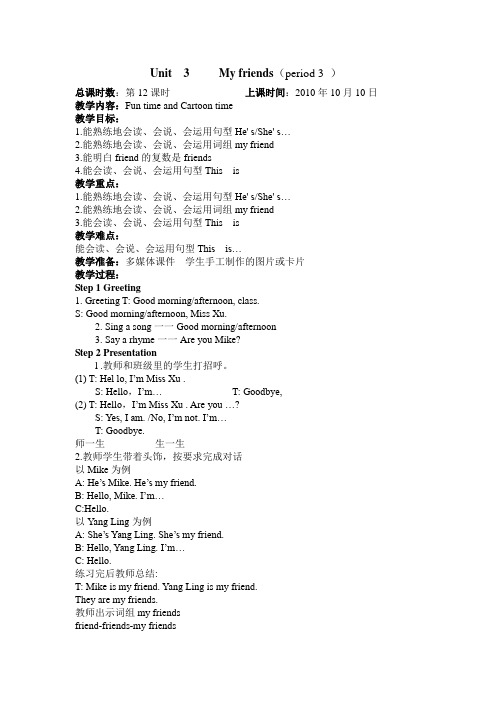
Unit 3 My friends(period 3 )总课时数:第12课时上课时间:2010年10月10日教学内容:Fun time and Cartoon time教学目标:1.能熟练地会读、会说、会运用句型He' s/She' s…2.能熟练地会读、会说、会运用词组my friend3.能明白friend的复数是friends4.能会读、会说、会运用句型This is教学重点:1.能熟练地会读、会说、会运用句型He' s/She' s…2.能熟练地会读、会说、会运用词组my friend3.能会读、会说、会运用句型This is教学难点:能会读、会说、会运用句型This is…教学准备:多媒体课件学生手工制作的图片或卡片教学过程:Step 1 Greeting1. Greeting T: Good morning/afternoon, class.S: Good morning/afternoon, Miss Xu.2. Sing a song一一Good morning/afternoon3. Say a rhyme一一Are you Mike?Step 2 Presentationl .教师和班级里的学生打招呼。
(1) T: Hel lo, I’m Miss Xu .S: Hello,I’m… T: Goodbye,(2) T: Hello,I’m Miss Xu . Are you …?S: Yes, I am. /No, I’m not. I’m…T: Goodbye.师一生生一生2.教师学生带着头饰,按要求完成对话以Mike为例A: He’s Mike. He’s my friend.B: Hello, Mike. I’m…C:Hello.以Yang Ling为例A: She’s Yang Ling. She’s my friend.B: Hello, Yang Ling. I’m…C: Hello.练习完后教师总结:T: Mike is my friend. Yang Ling is my friend.They are my friends.教师出示词组my friendsfriend-friends-my friends再次读课题Unit 3 My friends.3. Fun time教学(1).让学生拿出课前准备好的朋友照片,卡片或是图片。
- 1、下载文档前请自行甄别文档内容的完整性,平台不提供额外的编辑、内容补充、找答案等附加服务。
- 2、"仅部分预览"的文档,不可在线预览部分如存在完整性等问题,可反馈申请退款(可完整预览的文档不适用该条件!)。
- 3、如文档侵犯您的权益,请联系客服反馈,我们会尽快为您处理(人工客服工作时间:9:00-18:30)。
牛津幼儿英语3a教案
教案标题:牛津幼儿英语3A教案
教案目标:
1. 帮助幼儿学习并掌握牛津幼儿英语3A课程中的基本词汇和句型。
2. 培养幼儿的听、说、读、写能力,提高他们的英语交流能力。
3. 激发幼儿对英语学习的兴趣,培养他们的学习动力和自信心。
教案内容:
课程主题:At the Farm(在农场)
课程时长:45分钟
教学目标:
1. 学习并掌握新单词:cow(奶牛)、pig(猪)、sheep(羊)、chicken(鸡)、horse(马)。
2. 学习并掌握新句型:What's this? It's a cow/pig/sheep/chicken/horse.
3. 能够用英语描述农场上的动物。
教学准备:
1. 牛津幼儿英语3A教材和配套CD。
2. 农场动物的图片或玩具模型。
3. 黑板/白板和彩色粉笔/白板笔。
4. 单词卡片。
教学步骤:
Step 1: Warm-up (5分钟)
- 通过播放CD中的歌曲《Old MacDonald Had a Farm》,引导幼儿回忆并唱出
农场上的动物名称。
- 引导幼儿观察农场动物的图片或玩具模型,鼓励他们用英语表达出这些动物的名称。
Step 2: Presentation (10分钟)
- 准备单词卡片,依次出示cow、pig、sheep、chicken、horse的图片,并教授相应的单词。
- 引导幼儿跟读单词,并进行发音练习。
- 使用图片或玩具模型,示范并教授句型"What's this?"和"It's a
cow/pig/sheep/chicken/horse.",并引导幼儿模仿。
Step 3: Practice (15分钟)
- 通过教材中的练习活动,让幼儿进行听、说、读、写的综合练习。
- 播放CD中的对话,让幼儿跟读并模仿语音语调。
- 分组进行角色扮演,模拟农场场景,让幼儿用英语进行对话。
Step 4: Extension (10分钟)
- 制作一个简单的农场场景,包括动物和农场的背景。
- 分发农场动物的图片给幼儿,并要求他们根据图片描述出动物的名称。
- 鼓励幼儿用英语进行对话,描述农场上的动物和场景。
Step 5: Wrap-up (5分钟)
- 通过歌曲《Old MacDonald Had a Farm》进行复习,让幼儿唱出农场上的动物名称。
- 总结本节课所学的内容,并鼓励幼儿进行自我评价。
教学评估:
1. 在练习环节中观察幼儿的参与度和表现,了解他们对所学内容的掌握情况。
2. 在角色扮演和描述农场动物的活动中,评估幼儿的口语表达能力和语法运用能力。
3. 收集幼儿的练习作业,评估他们的书写和阅读能力。
教学反思:
1. 根据幼儿的实际情况,适当调整教学步骤和活动内容,确保教学效果。
2. 鼓励幼儿多进行口语练习,提高他们的英语交流能力。
3. 及时给予幼儿肯定和鼓励,激发他们的学习动力和自信心。
以上是一份针对牛津幼儿英语3A教案的建议和指导。
根据具体教学环境和幼儿的实际情况,可以对教案进行适当调整和改进,以达到更好的教学效果。
